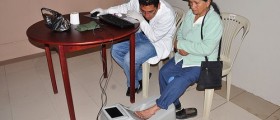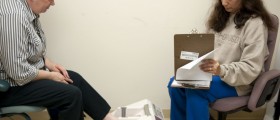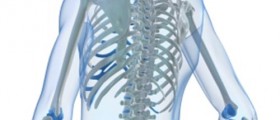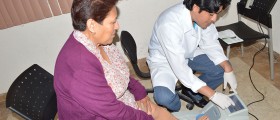
Osteoporosis is a medical condition that features with loss of bone mineral density and progressive thinning of bone tissue. Bones in people suffering from osteoporosis become 'porous', weak and brittle and are highly susceptible to fractures. Clinical Characteristics and Causes of Osteoporosis
Osteoporosis is in early stages practically asymptomatic and can be only discovered accidentally if one needs an X-ray of certain bones in other purposes. However, once the disease has progressed sufficiently, patients develop different symptoms and signs depending on the affected bones and potential complications such as fractures.
Many people complain about pain or tenderness of the affected bones. They also suffer from frequent fractures (with little or no trauma). Osteoporosis of the vertebral column causes loss of height, back pain and stooped posture or kyphosis.
The exact cause of osteoporosis remains unknown. Still, the condition obviously develops as a result of changes in bone remodeling process. The condition is either a consequence of insufficient formation of new bone or excessive reabsorption of old bone.
In women the main cause of osteoporosis is a drop of estrogen which typically affects menopausal women. In men osteoporosis may be associated with a drop in testosterone.
Osteoporosis is also frequent among bedridden patients, those suffering from chronic rheumatoid or kidney disease and patients with eating disorders. The condition can be a side effect of certain treatments (therapy with corticosteroids) or develops as a consequence of other illnesses such as hyperparathyroidism and vitamin D deficiency.
Therapy for Osteoporosis
There are many drugs which can slow down bone loss and preserve bone mass and bone density.
Bisphosphonates belong to a group of medications which efficiently inhibits bone breakdown. They preserve bone mass and this way reduce the risk of fractures. Alendronate, ibandronate and risedronate are only several bisphosphonates used in treatment for osteoporosis. These drugs bring relief to many patients especially those suffering from steroid- induced osteoporosis. They are taken once a week or once a month and if a patients cannot take oral bisphosphonates, he/ she may receive periodic intravenous infusions of the drug.
Raloxifene belongs to selective estrogen receptor modulators (SERMs). Its effects are similar to the effects of estrogen. The only difference is that raloxifene does not carry any risk of uterine or breast cancer, which is the case with estrogen replacement therapy.
Calcitonin is produced by the thyroid gland. This hormone may reduce bone loss and prevent fractures. It is not as efficient as bisphosphonates. This is why calcitonin is only recommended for patients who cannot be treated with other medications.
And finally, teriparatide is a drug prescribed to postmenopausal women and men who are prone to fractures.
Hormone therapy for osteoporosis (estrogen for menopausal women) is efficient but carries several side effects including blood clots, endometrial cancer, breast cancer etc. And finally, bone strength as well as muscle strength may improve with the assistance of physical therapy.

















Your thoughts on this
Loading...